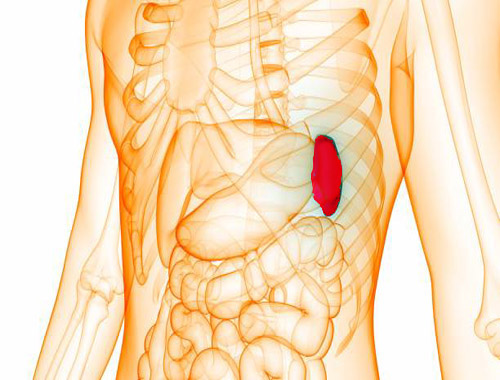Splenomegaly

Published: 18 Jun 2025
ICD9: 789.2 ICD10: R16.1 ICD11: ME10.01
Splenomegaly refers to the enlargement of the spleen.
The spleen is an organ located in the upper left abdomen, under the rib cage. It plays a vital role in filtering blood, removing old and damaged blood cells, storing white blood cells and platelets, and fighting infection.
When the spleen becomes enlarged, it can indicate an underlying medical condition. It's not a disease in itself, but rather a symptom of another problem.
Causes of Splenomegaly:
Splenomegaly can be caused by a wide range of conditions, including:
![]() Infections:
Infections:![]()

![]() Viral: Infectious mononucleosis (Mono), Cytomegalovirus (CMV), Hepatitis
Viral: Infectious mononucleosis (Mono), Cytomegalovirus (CMV), Hepatitis![]()

![]() Bacterial: Endocarditis, Tuberculosis, Brucellosis
Bacterial: Endocarditis, Tuberculosis, Brucellosis![]()

![]() Parasitic: Malaria, Leishmaniasis
Parasitic: Malaria, Leishmaniasis
![]() Liver diseases:
Liver diseases:![]()

![]() Cirrhosis
Cirrhosis![]()

![]() Portal hypertension
Portal hypertension
![]() Blood disorders:
Blood disorders:![]()

![]() Hemolytic anemias (e.g., sickle cell anemia, hereditary spherocytosis)
Hemolytic anemias (e.g., sickle cell anemia, hereditary spherocytosis)![]()

![]() Thalassemia
Thalassemia![]()

![]() Leukemia
Leukemia![]()

![]() Lymphoma
Lymphoma![]()

![]() Myeloproliferative disorders (e.g., polycythemia vera, essential thrombocythemia)
Myeloproliferative disorders (e.g., polycythemia vera, essential thrombocythemia)
![]() Inflammatory conditions:
Inflammatory conditions:![]()

![]() Sarcoidosis
Sarcoidosis![]()

![]() Systemic lupus erythematosus (SLE)
Systemic lupus erythematosus (SLE)![]()

![]() Rheumatoid arthritis
Rheumatoid arthritis
![]() Infiltrative diseases:
Infiltrative diseases:![]()

![]() Gaucher disease
Gaucher disease![]()

![]() Niemann-Pick disease
Niemann-Pick disease![]()

![]() Amyloidosis
Amyloidosis
![]() Cysts and tumors:
Cysts and tumors:![]()

![]() Splenic cysts
Splenic cysts![]()

![]() Primary splenic tumors
Primary splenic tumors![]()

![]() Metastatic tumors
Metastatic tumors
![]() Congestive splenomegaly:
Congestive splenomegaly:![]()

![]() Heart failure
Heart failure![]()

![]() Portal vein thrombosis
Portal vein thrombosis![]()

![]() Splenic vein thrombosis
Splenic vein thrombosis
Symptoms of Splenomegaly:
Many people with an enlarged spleen may not experience any symptoms. However, when symptoms do occur, they can include:
![]() Fullness or pain in the upper left abdomen: This is the most common symptom. The pain may radiate to the left shoulder.
Fullness or pain in the upper left abdomen: This is the most common symptom. The pain may radiate to the left shoulder.
![]() Feeling full after eating only a small amount: The enlarged spleen can press on the stomach.
Feeling full after eating only a small amount: The enlarged spleen can press on the stomach.
![]() Fatigue: This can be caused by anemia or the underlying condition causing the splenomegaly.
Fatigue: This can be caused by anemia or the underlying condition causing the splenomegaly.
![]() Frequent infections: The spleen's filtering function may be impaired.
Frequent infections: The spleen's filtering function may be impaired.
![]() Easy bleeding: The enlarged spleen may trap platelets, leading to thrombocytopenia (low platelet count).
Easy bleeding: The enlarged spleen may trap platelets, leading to thrombocytopenia (low platelet count).
![]() Anemia: Due to increased destruction of red blood cells by the spleen.
Anemia: Due to increased destruction of red blood cells by the spleen.
Diagnosis:
Splenomegaly is often discovered during a physical examination when a doctor palpates (feels) the abdomen. Other diagnostic tests include:
![]() Blood tests: Complete blood count (CBC), liver function tests, and tests to check for infections.
Blood tests: Complete blood count (CBC), liver function tests, and tests to check for infections.
![]() Imaging tests:
Imaging tests:![]()

![]() Ultrasound: A non-invasive way to visualize the spleen.
Ultrasound: A non-invasive way to visualize the spleen.![]()

![]() CT scan: Provides a more detailed image of the spleen and surrounding organs.
CT scan: Provides a more detailed image of the spleen and surrounding organs.![]()

![]() MRI: Can be used to further evaluate the spleen.
MRI: Can be used to further evaluate the spleen.![]()

![]() Bone marrow biopsy: May be necessary to evaluate blood disorders.
Bone marrow biopsy: May be necessary to evaluate blood disorders.
Treatment:
Treatment for splenomegaly depends on the underlying cause. Options may include:
![]() Treating the underlying condition: Addressing the cause of the splenomegaly is the primary goal. For example, antibiotics for infections, medication for blood disorders, or surgery for certain tumors.
Treating the underlying condition: Addressing the cause of the splenomegaly is the primary goal. For example, antibiotics for infections, medication for blood disorders, or surgery for certain tumors.
![]() Splenectomy (surgical removal of the spleen): This is usually a last resort and is considered when the enlarged spleen causes severe complications or when the underlying cause cannot be treated effectively. Following a splenectomy, patients need to be vaccinated against certain infections because the spleen's filtering function is lost.
Splenectomy (surgical removal of the spleen): This is usually a last resort and is considered when the enlarged spleen causes severe complications or when the underlying cause cannot be treated effectively. Following a splenectomy, patients need to be vaccinated against certain infections because the spleen's filtering function is lost.
![]() Watchful waiting: In some cases, if the splenomegaly is mild and not causing symptoms, the doctor may recommend monitoring the condition without immediate treatment.
Watchful waiting: In some cases, if the splenomegaly is mild and not causing symptoms, the doctor may recommend monitoring the condition without immediate treatment.
Importance of Seeking Medical Attention:
If you suspect you have splenomegaly, it is important to see a doctor for diagnosis and treatment. Identifying and treating the underlying cause is crucial for preventing complications. Self-treating is not advised.